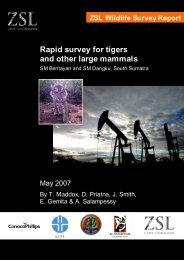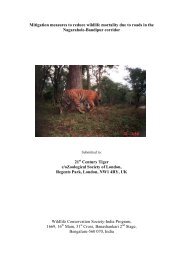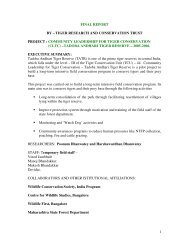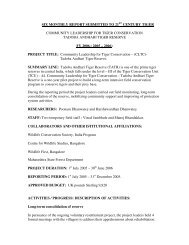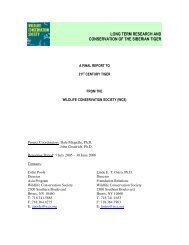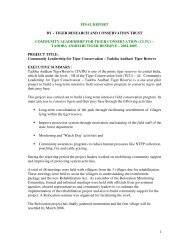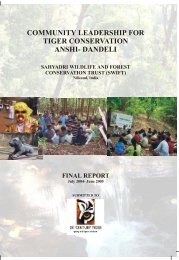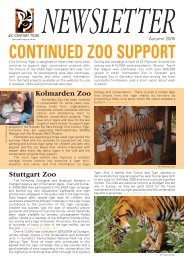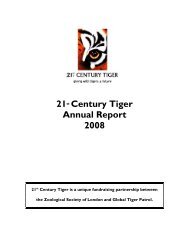The conservation of tigers and other wildlife in oil palm plantations
The conservation of tigers and other wildlife in oil palm plantations
The conservation of tigers and other wildlife in oil palm plantations
Create successful ePaper yourself
Turn your PDF publications into a flip-book with our unique Google optimized e-Paper software.
Non-r<strong>and</strong>om camera placement<br />
Cameras were placed us<strong>in</strong>g two methods. Some cameras, referred to here as “nonr<strong>and</strong>om<br />
cameras” were used to target <strong>tigers</strong> <strong>and</strong> were set up on tracks with known<br />
tiger activity, particularly at junctions, to maximise the chances <strong>of</strong> a tiger pass<strong>in</strong>g.<br />
Ideally such cameras should be set up <strong>in</strong> pairs to allow both sides <strong>of</strong> recognisable<br />
animals to be photographed (Karanth <strong>and</strong> Nichols, 2002); however, the tiger cameras<br />
were primarily set up to keep track <strong>of</strong> already known <strong>tigers</strong> rather than to survey new<br />
areas, therefore cameras were set up s<strong>in</strong>gly but over a larger area. <strong>The</strong>se cameras<br />
were left <strong>in</strong> place <strong>in</strong>def<strong>in</strong>itely once a successful location for tiger photos was identified.<br />
R<strong>and</strong>om camera placement<br />
Other cameras, referred to as “r<strong>and</strong>om cameras” were set up r<strong>and</strong>omly so as to<br />
m<strong>in</strong>imise bias <strong>in</strong> the species targeted or the chances <strong>of</strong> photograph<strong>in</strong>g <strong>in</strong>dividuals.<br />
<strong>The</strong>se cameras were set up <strong>in</strong> grids <strong>of</strong> sixteen cameras <strong>in</strong> a 4x4 configuration, with<br />
500m spac<strong>in</strong>g between cameras. <strong>The</strong> grids were then placed <strong>in</strong> target areas along UTM<br />
gridl<strong>in</strong>es. <strong>The</strong> actual camera position was flexible with<strong>in</strong> 100m <strong>of</strong> the r<strong>and</strong>omly chosen<br />
po<strong>in</strong>t to avoid plac<strong>in</strong>g cameras <strong>in</strong> positions with almost no chance <strong>of</strong> any photographs<br />
(for example <strong>in</strong> the middle <strong>of</strong> a thick bush) <strong>and</strong> cameras were placed on animal trails,<br />
tracks, water<strong>in</strong>g holes or cross<strong>in</strong>g po<strong>in</strong>ts with<strong>in</strong> the 100m radius. <strong>The</strong> cameras were left<br />
<strong>in</strong> position for one month, giv<strong>in</strong>g a maximum <strong>of</strong> 496 trap nights (16x31), if every<br />
camera worked for every night. Analysis was carried out us<strong>in</strong>g the number <strong>of</strong><br />
<strong>in</strong>dependent photographs for each species per trap night on which the camera was<br />
def<strong>in</strong>itely work<strong>in</strong>g (rather than the total time <strong>in</strong> the field).<br />
Figure 5 – A Photoscout camera-trap (left). Follow<strong>in</strong>g persistent theft <strong>and</strong> v<strong>and</strong>alism some<br />
cameras were set up <strong>in</strong> metal cages, sunk <strong>in</strong>to concrete bases (right).<br />
Plott<strong>in</strong>g total species recorded by camera-traps over time show a curve levell<strong>in</strong>g <strong>of</strong>f at<br />
about 6000 trap nights, <strong>in</strong>dicat<strong>in</strong>g that most <strong>of</strong> the camera-trappable species had been<br />
detected dur<strong>in</strong>g the study.<br />
Figure 6 - Species detection rate by camera-trapp<strong>in</strong>g<br />
18 Wildlife <strong>conservation</strong> <strong>in</strong> <strong>oil</strong> <strong>palm</strong> <strong>plantations</strong>




